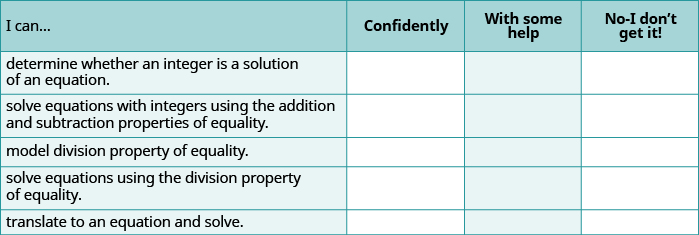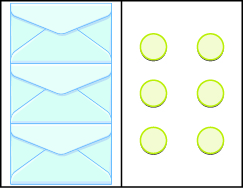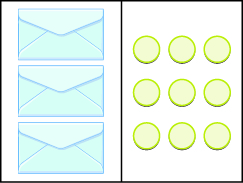3.10: Solve Equations Using Integers; The Division Property of Equality (Part 2)
- Page ID
- 4989
Translate to an Equation and Solve
In the past several examples, we were given an equation containing a variable. In the next few examples, we’ll have to first translate word sentences into equations with variables and then we will solve the equations.
Translate and solve: five more than \(x\) is equal to \(−3\).
Solution
| Translate. | x + 5 = −3 |
| Subtract 5 from both sides. | x + 5 − 5 = −3 − 5 |
| Simplify. | x = −8 |
Check the answer by substituting it into the original equation.
\[\begin{split} x + 5 & = -3 \\ -8 + 5 & \stackrel{?}{=} -3 \\ -3 & = -3 \; \checkmark \end{split} \nonumber \]
Translate and solve: Seven more than \(x\) is equal to \(−2\).
- Answer
-
\(x+7=-2\); \(x=-9\)
Translate and solve: Eleven more than \(y\) is equal to \(2\).
- Answer
-
\(y+11=2\); \(y=-9\)
Translate and solve: the difference of \(n\) and \(6\) is \(−10\).
Solution
| Translate. | n − 6 = −10 |
| Add 6 to each side. | n − 6 + 6 = −10 + 6 |
| Simplify. | n = −4 |
Check the answer by substituting it into the original equation.
\[\begin{split} n - 6 & = -10 \\ -4 - 6 & \stackrel{?}{=} -10 \\ -10 & = -10 \; \checkmark \end{split} \nonumber \]
Translate and solve: The difference of \(p\) and \(2\) is \(−4\).
- Answer
-
\(p-2=-4\); \(p=-2\)
Translate and solve: The difference of \(q\) and \(7\) is \(−3\).
- Answer
-
\(q-7=-3\); \(q=4\)
Translate and solve: the number \(108\) is the product of \(−9\) and \(y\).
Solution
| Translate. | 108 = −9y |
| Divide by −9. | $$\dfrac{108}{-9} = \dfrac{-9y}{-9}$$ |
| Simplify. | −12 = y |
Check the answer by substituting it into the original equation.
\[\begin{split} 108 & = -9y \\ 108 & \stackrel{?}{=}-9(-12) \\ 108 & = 108 \; \checkmark \end{split} \nonumber \]
Translate and solve: The number \(132\) is the product of \(−12\) and \(y\).
- Answer
-
\(132=-12y\); \(y=-11\)
Translate and solve: The number \(117\) is the product of \(−13\) and \(z\).
- Answer
-
\(117=-13z\); \(z=-9\)
Access Additional Online Resources
Key Concepts
- How to determine whether a number is a solution to an equation.
- Step 1. Substitute the number for the variable in the equation.
- Step 2. Simplify the expressions on both sides of the equation.
- Step 3. Determine whether the resulting equation is true.
- If it is true, the number is a solution.
- If it is not true, the number is not a solution.
- Properties of Equalities
Subtraction Property of Equality Addition Property of Equality - Division Property of Equality
- For any numbers \(a,b,c\) and \(c\neq 0\), if \(a=b\), then \(\dfrac{a}{c}=\dfrac{b}{c}\)
Practice Makes Perfect
Determine Whether a Number is a Solution of an Equation
In the following exercises, determine whether each number is a solution of the given equation.
- 4x − 2 = 6
- x = −2
- x = −1
- x = 2
- 4y − 10 = −14
- y = −6
- y = −1
- y = 1
- 9a + 27 = −63
- a = 6
- a = −6
- a = −10
- 7c + 42 = −56
- c = 2
- c = −2
- c = −14
Solve Equations Using the Addition and Subtraction Properties of Equality
In the following exercises, solve for the unknown.
- n + 12 = 5
- m + 16 = 2
- p + 9 = −8
- q + 5 = −6
- u − 3 = −7
- v − 7 = −8
- h − 10 = −4
- k − 9 = −5
- x + (−2) = −18
- y + (−3) = −10
- r − (−5) = −9
- s − (−2) = −11
Model the Division Property of Equality
In the following exercises, write the equation modeled by the envelopes and counters and then solve it.
Solve Equations Using the Division Property of Equality
In the following exercises, solve each equation using the division property of equality and check the solution.
- 5x = 45
- 4p = 64
- −7c = 56
- −9x = 54
- −14p = −42
- −8m = −40
- −120 = 10q
- −75 = 15y
- 24x = 480
- 18n = 540
- −3z = 0
- 4u = 0
Translate to an Equation and Solve
In the following exercises, translate and solve.
- Four more than n is equal to 1.
- Nine more than m is equal to 5.
- The sum of eight and p is −3.
- The sum of two and q is −7.
- The difference of a and three is −14.
- The difference of b and 5 is −2.
- The number −42 is the product of −7 and x.
- The number −54 is the product of −9 and y.
- The product of f and −15 is 75.
- The product of g and −18 is 36.
- −6 plus c is equal to 4.
- −2 plus d is equal to 1.
- Nine less than n is −4.
- Thirteen less than n is −10 .
Mixed Practice
In the following exercises, solve.
- (a) x + 2 = 10 (b) 2x = 10
- (a) y + 6 = 12 (b) 6y = 12
- (a) −3p = 27 (b) p − 3 = 27
- (a) −2q = 34 (b) q − 2 = 34
- a − 4 = 16
- b − 1 = 11
- −8m = −56
- −6n = −48
- −39 = u + 13
- −100 = v + 25
- 11r = −99
- 15s = −300
- 100 = 20d
- 250 = 25n
- −49 = x − 7
- 64 = y − 4
Everyday Math
- Cookie packaging A package of 51 cookies has 3 equal rows of cookies. Find the number of cookies in each row, c, by solving the equation 3c = 51.
- Kindergarten class Connie’s kindergarten class has 24 children. She wants them to get into 4 equal groups. Find the number of children in each group, g, by solving the equation 4g = 24.
Writing Exercises
- Is modeling the Division Property of Equality with envelopes and counters helpful to understanding how to solve the equation 3x = 15? Explain why or why not.
- Suppose you are using envelopes and counters to model solving the equations x + 4 = 12 and 4x = 12. Explain how you would solve each equation.
- Frida started to solve the equation −3x = 36 by adding 3 to both sides. Explain why Frida’s method will not solve the equation.
- Raoul started to solve the equation 4y = 40 by subtracting 4 from both sides. Explain why Raoul’s method will not solve the equation.
Self Check
(a) After completing the exercises, use this checklist to evaluate your mastery of the objectives of this section.

(b) Overall, after looking at the checklist, do you think you are well-prepared for the next Chapter? Why or why not?
Contributors and Attributions
- Lynn Marecek (Santa Ana College) and MaryAnne Anthony-Smith (formerly of Santa Ana College). This content produced by OpenStax and is licensed under a Creative Commons Attribution License 4.0 license.






